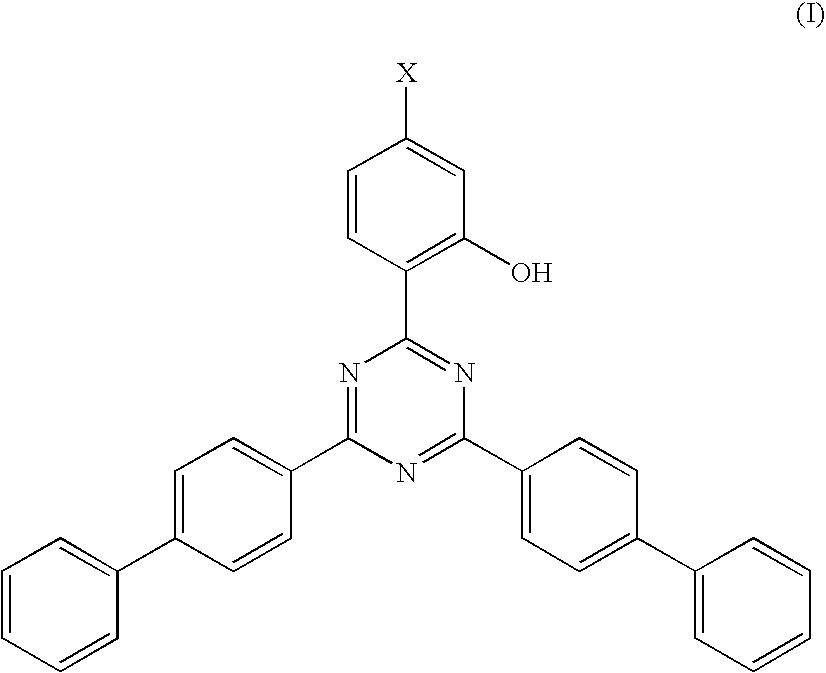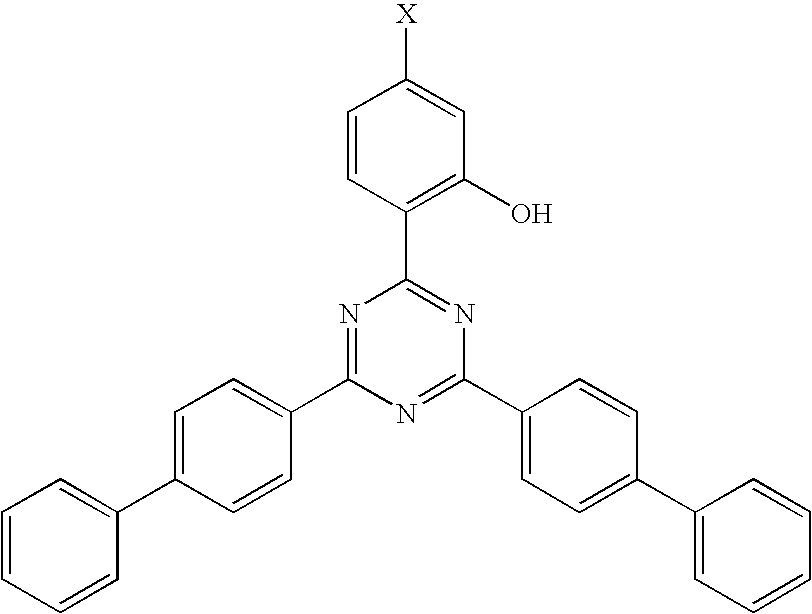UV protective compositions, processes for preparing such compositions, methods of coating substrates therewith and multi-layer articles formed thereby
a technology of protective compositions and compositions, which is applied in the direction of adhesive types, synthetic resin layered products, coatings, etc., can solve the problems of economic inefficiency, damage to polycarbonate, and inability to filter out ultraviolet light, and achieve good uv protective
- Summary
- Abstract
- Description
- Claims
- Application Information
AI Technical Summary
Benefits of technology
Problems solved by technology
Method used
Image
Examples
example 1
[0057]A solids content of 9.96% was determined for the commercially available thick film primer SHP 470 (Momentive Performance Materials Inc. Wilton, Conn. USA) using method A.
[0058]The viscosity of this paint solution was determined using a flow cup with a 4 mm diameter nozzle in accordance with method B, giving a value of 53.41 s. The determination of the viscosity using a flow cup with a 2 mm diameter nozzle was not possible because the paint solution was too ductile in flowability.
[0059]This paint was applied by the flow-coating method to a polycarbonate sheet (injection-moulded optical-grade polycarbonate (PC) sheets made from Makrolon® 2808 (Bayer MaterialScience AG; medium-viscosity bisphenol A polycarbonate, MFR 10 g / 10 min in accordance with ISO 1133 at 300° C. and 1.2 kg, without UV stabilisation) and measuring 10.5×15×0.32 cm), allowed to dry for 30 min and then cured for 15 min at 125° C.
[0060]In the flow-coating direction from flow edge to drip edge, a film thickness of...
example 2
[0062]A stock paint solution was produced from the commercially available thick film primer SHP 470 (solids content 9.90% and viscosity with a 4 mm cup 46.25 s (for determination see methods A and B) and a 1:1 solvent blend of diacetone alcohol and 1-methoxy-2-propanol, by measuring out 300.0 g of SHP 470 (9.9 wt. %) and adding 97.5 g each of diacetone alcohol and 1-methoxy-2-propanol whilst stirring. The solution obtained is referred to as stock solution 2A.
[0063]0.12 g of CGL 479 were added whilst stirring to 100 g of this stock solution 2A to produce stock solution 2B with 2 wt. % of CGL 479 relative to the experimentally determined solids content of A (for determination see method A) of 5.95%.
[0064]0.30 g of CGL 479 were added to a further 100 g of stock solution 2A to produce stock solution 2C with 5 wt. % of the UV absorber from the biphenyl triazine class relative to the experimentally determined solids content of 2A.
[0065]The following characteristic values were obtained for...
example 3
[0075]The commercially available thick film primer SHP 470 (solids content 9.90% and viscosity with a 4 mm cup 46.25 s (for determination see methods A and B)) was used. 65 g of a 1:1 solvent blend (based on weight) of diacetone alcohol and 1-methoxy-2-propanol and 0.49 g of CGL 479 were added to 100 g of the solution. Paint solution example 3A was obtained containing 5 wt. % of CGL 479 relative to the experimentally determined solids content (for determination see method A) of 5.95%.
[0076]Further dilutions, examples 3B to 3D, are then produced in the same way. The initial weights are listed in Table 4 below:
TABLE 4ActualCommercialUV absorbersolidsExampleSHP 470CGL 479Solventcontent3A100 g0.49 g 65.00 g5.95%3B100 g0.49 g 98.00 g5.08%3C100 g0.49 g147.50 g4.12%3D100 g0.49 g230.00 g3.18%
[0077]The following characteristic values were obtained for these four paint solutions:
TABLE 5SolidsViscosityViscosityExamplecontent2 mm cup4 mm cupComments3A5.95%106.4 sec 15.15 sec3B5.08%84.3 secnd3C4...
PUM
| Property | Measurement | Unit |
|---|---|---|
| wt. % | aaaaa | aaaaa |
| temperature | aaaaa | aaaaa |
| thicknesses | aaaaa | aaaaa |
Abstract
Description
Claims
Application Information
 Login to View More
Login to View More - R&D
- Intellectual Property
- Life Sciences
- Materials
- Tech Scout
- Unparalleled Data Quality
- Higher Quality Content
- 60% Fewer Hallucinations
Browse by: Latest US Patents, China's latest patents, Technical Efficacy Thesaurus, Application Domain, Technology Topic, Popular Technical Reports.
© 2025 PatSnap. All rights reserved.Legal|Privacy policy|Modern Slavery Act Transparency Statement|Sitemap|About US| Contact US: help@patsnap.com



